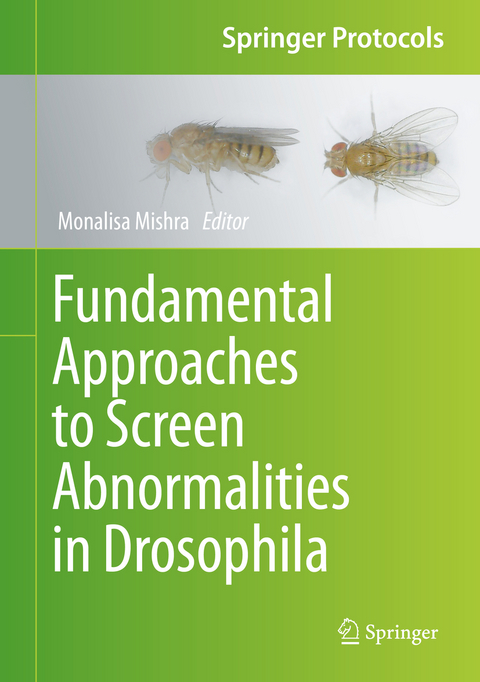
Fundamental Approaches to Screen Abnormalities in Drosophila
Springer-Verlag New York Inc.
978-1-4939-9755-8 (ISBN)
The book explains how various fluorescent dyes and the comet assay can be used to identify DNA damage, and elaborates on the analysis of the eye, antennae, imaginal disc, gut and muscle damage under bright field and fluorescent microscopes. It covers the analysis of hemolymph using Giemsa staining; determining the functionality of channel proteins, eye and mechanosensory organs in adults and larvae using various behavioral assays; and metal detection and structural analysis for various tissues using SEM. In closing, it addresses the analysis of Drosophila’s eye and head via paraffin section; measurement of reactive oxygen species from various tissues via FACS; and the CRISPER technique for gene editing and analysis of micro RNA mutations.
Dr. Monalisa Mishra is an Assistant Professor at the Department of Life Sciences, National Institute of Technology (NIT) in Rourkela, India. She completed her Ph.D. at the University of Bremen, Germany, prior to postdoctoral studies at the School of Medicine, University of San Diego, California, USA; Department of Biological Sciences, Indiana University, Bloomington, USA; and Max Plank Institute of Cell Biology and Genetics, Dresden, Germany. Further, she previously served as an Assistant Professor at the Department of Biological Sciences, BITS in Pilani, India from 2012-2014. Currently, her lab at the NIT Rourkela is investigating various factors that can affect the development of Drosophila’s sensory organs. The lab’s findings have been published in many prominent international journals.
Chapter 1. Preparation of normal food and modified food for Drosophila.- Chapter 2. Protocol for dissection of various tissues (gut, imaginal disc, fat body, ovary, testes) in larva and adult fly.- Chapter 3. Biochemical estimation of various metabolites (protein, lipid, carbohydrate, trehalose, cholesterol).- Chapter 4. Detection of fat within the Drosophila body.- Chapter 5. Estimation of reactive oxygen species (ROS) production in Drosophila cells.- Chapter 6. Methods to check the metabolic activity of fly.- Chapter 7. Detection of DNA damage in larva and adult stage of Drosophila by Fluorescent microscopy.- Chapter 8. Imaging of larva/adult gut damage using Bright field microscopy.- Chapter 9. A comet assay to detect severity of DNA damage.- Chapter 10. Checking the abnormality in hemolymph by Giemsa stain.- Chapter 11. Analysis of channel proteins.- Chapter 12. Various behavioral assays in larva and adult Drosophila.- Chapter 13. Detection of various metals within the tissue by Energy dispersive X-ray (EDX) through SEM and FTIR.- Chapter 14. Imaging of various sections of fly through Scanning Electron Microscopy (SEM).- Chapter 15. Preparation of thin sections and fixation of various tissues of Drosophila for examination by transmission electron microscopy (TEM).- Chapter 16. Flow cytometric analysis of Drosophila cells.
| Erscheinungsdatum | 27.01.2020 |
|---|---|
| Reihe/Serie | Springer Protocols Handbooks |
| Zusatzinfo | 111 Illustrations, color; 5 Illustrations, black and white; VII, 265 p. 116 illus., 111 illus. in color. |
| Verlagsort | New York |
| Sprache | englisch |
| Maße | 178 x 254 mm |
| Themenwelt | Naturwissenschaften ► Biologie ► Genetik / Molekularbiologie |
| Naturwissenschaften ► Biologie ► Zoologie | |
| Schlagworte | Behavioral defect • biochemical methods • Drosophila • histological techniques • Microscopy analysis |
| ISBN-10 | 1-4939-9755-6 / 1493997556 |
| ISBN-13 | 978-1-4939-9755-8 / 9781493997558 |
| Zustand | Neuware |
| Haben Sie eine Frage zum Produkt? |
aus dem Bereich


